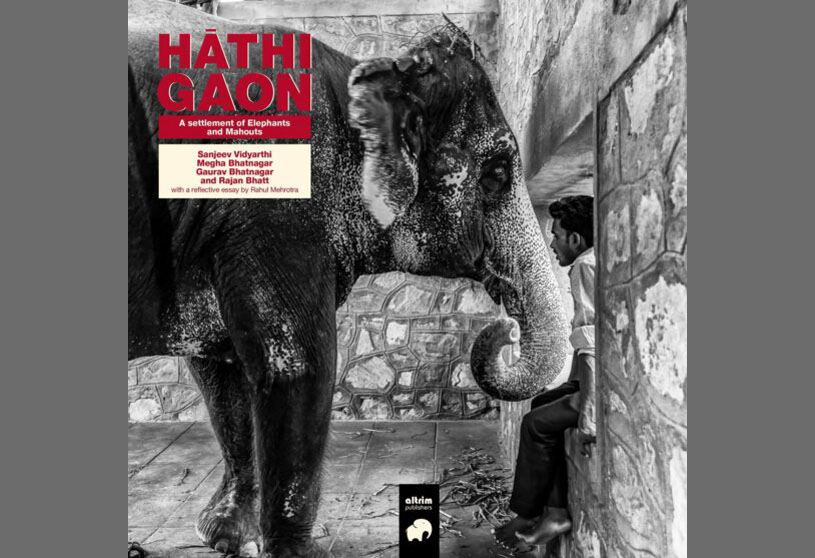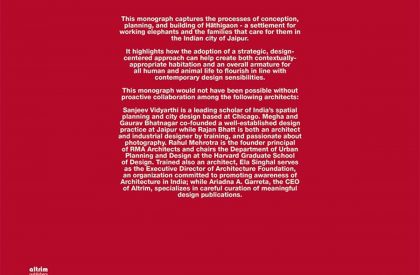About the Book
This monograph illustrates the processes of conception, planning, and building of Hāthigaon – a settlement for working elephants and the families that care for them in the Indian city of Jaipur. It highlights how the adoption of a strategic, design-centered approach can help create both contextually-appropriate habitation and an overall armature for all human and animal life to flourish in line with contemporary design sensibilities.
This book would not have been possible without proactive collaboration among the authors, RMA Architects and the Architecture Foundation.
This book will available from SPRING 2021
Keep yourself updated by clicking here.
About the Author
Dr Sanjeev Vidyarthi
Architect Sanjeev has long, fruitful ties with Jaipur. He did foundational work along with his friends establishing the city’s leading design practice—Aayojan, which sponsored the state’s first school of architecture in 1998, before turning to other intellectual pursuits. Author of several books and essays illustrating the nature of Jaipur’s city planning and physical development over time, Sanjeev is currently a professor of urban planning and policy at the University of Illinois, Chicago.
Megha Bhatnagar
Born and raised in Jaipur, Megha is a leading architect of the city today. Her practice pays particular attention to crafting simple and elegant designs suited to the cause and context. Her well-known design firm, established in 1998 with husband Gaurav Bhatnagar, has been widely awarded for a variety of meaningful projects. Megha cares deeply for her hometown and seeks to conserve and advance its rich architectural traditions via purposeful design and outreach work.
Gaurav Bhatnagar
After completing architectural studies from MNIT, and apprenticing with several architectural firms, Gaurav established a progressive design firm with Megha Bhatnagar at Jaipur in 1998. Several regional and national awards, recognizing their passionate practice and professional commitment to meaningful design work, quickly followed. Gaurav’s growing interest in Nature and Nature photography, which started as a mere hobby, increasingly impacted his design outlook by providing an enhanced understanding of multidimensional relationships between architectural ideas, building design and physical landscape. He has, since then, turned attention to designing ecologically-friendly and environmentally-sustainable projects.
Rajan Bhatt
Rajan is an architect and industrial designer by training, and passionate about touring, art and photography. He believes design plays a crucial role shaping the human life and better design can enhance the quality of how we live, work, and play.
He heads a multidisciplinary design firm called Bezel Design, which he founded; the firm provides comprehensive design and build services in the fields of spatial design and visual communication. Rajan grew up in Jaipur and established Mool Foundation, city’s premier art & design forum as a tribute to his father who was the Rajasthan state’s Chief Town Planner and an artist at heart.
Rahul Mehrotra is the founder principal of RMA Architects and chairs the Department of Urban Planning and Design at the Harvard Graduate School of Design. Trained also as architects, Ela Singhal serves as the Executive Director of Architecture Foundation, an organization committed to promote awareness of Architecture in India.
Book Reviews
Hathigaon: A Settlement of Elephants and Mahouts chronicles a successful project designed for elephants and their caregivers, first of its kind in India. A new ecology for an arid region is created for an elephant habitat through design interventions. Water is the keystone of design–its skillful capturing in the hot dry climate of Rajasthan ensures the elephants’ (and human) well-being, satisfying a gamut of needs from quenching thirst to playful bathing. Greenery essential for shade, soil conservation, and visual relief, and use of local building materials create a distinctive look and a pleasant ambience. Spatial layouts of housing and open spaces foster human-elephant interactions merging the traditional Than courtyard with the open-to-sky activity spaces in which elephants, mahouts, and visitors are comfortable. Hathigaon is exemplary in treating landscape as the focus of design and architecture as subservient, as it should be, given the social, cultural, and environmental contexts of this unique elephant village.
–Professor Amita Sinha, University of Illinois Urbana-Champaign
This book is remarkable in more than many ways. It focuses upon one single project and studies it deeply in the context of the region, the place, the people, and the special animals. It does not simply sing paeans of the architect or building design but analyses the project deeply by paying attention to the invaluable contribution of various other actors who contributed meaningfully to the making of Hathigaon. The book illustrates the project by narrating place history, ecology, biodiversity, and the many complex problems faced by the project architect.
For instance, the book describes how the architect had to be both an interlocutor and documenter of local oral histories while imagining a potential future when such a facility will no longer be required, and the land would eventually turn into a forest and biodiversity hub. The book brings forth the parallel design and planning approaches needed in complex projects like Hathigaon where landscape and architecture work in tandem while navigating the labyrinthine bureaucracy together. In this sense, the book brings out the designers’ passion needed to work on such an extraordinary project without making a hero of the architect. I wonder, why comprehensive books like this are not written explaining other innovative design projects in contemporary India?
-Chitra Vishwanath, Principal architect Biome, Bangalore
This book records the story of creation of Hathigaon in a rather unusual and fascinating manner. To build a settlement for 105 elephants along with 63 families that look after them, in a desert environment, is in itself a challenging task. But what is more amazing is the conversion of this shared space into a sensitively landscaped complex over a period of nine years while seamlessly integrating the built structures within.
The project is notable for several unique features which include the conversion of a system of natural rainwater drainage channels into a series of lakes and ponds. The design of the settlement itself is sensitively based on the needs of the elephants located in an environment that is not at all close to what is their natural habitat. The buildings themselves are simple and beautifully organized with a series of courtyards and connected open spaces. The recognition of the close relationship between the animals and the caretaking families including children is a fascinating revelation. It is the architect’s close interaction with all the different people who made this complex happen and the narration of their individual experiences that makes this most unusual book so enjoyable to read.
-Ranjit Sabikhi, Scholar-practitioner, New Delhi
Hāthigāon: A Settlement of Elephants and Mahouts is a remarkable book about the architecture for the ‘other’, the ‘unknown’. In it comes alive an analytical spatial narrative about the integrative design of the Thans within the layout of a settlement located at the foot of Amer Fort near Jaipur, Rajasthan for elephants and the families of their caretakers. Designed by RMA architects, Hāthigāon’s spatial layout centres around water bodies and socializing spaces for humans and elephants in an innovative manner. The fact that the local ecology and natural elements remain omnipresent throughout the project’s design make Hāthigāon an exemplar. Interviews with key project actors and designers make this book well-rounded and absorbing. Importantly, this publication is a rare effort at critical analysis and design evaluation of a successful project which is rather unusual in this country. It also provides an inspiring example and robust template for studying India’s contemporary architectural landscape.
-Professor Miki Desai, CEPT University, Ahmedabad
HATHI GAON, A Settlement of Elephants and Mahouts narrates the story of a unique, purposefully-designed place in an imaginative way. A delightful source of knowledge and insights, this book inspires the reader to think about the idea of studying carefully-designed projects for unearthing new knowledge while learning with fresh eyes.
We first encountered Hathi Gaon in 2008 and showcased the project same year in the Summer Issue of LA Journal. Great to see that the project has continued to celebrate the close companionship of humans and elephants in a remarkable way – beginning from the formulation of design brief and ending with the project design and building on the actual ground. By paying attention to the project’s rich regional context, Hathigaon reaffirms the faith in the crucial idea of working with natural ecology and environs of the site as the principal way towards sustainable future of local places. Perhaps most important, the project successfully transgresses supposedly-strict boundaries of specializations of spatial design disciplines by creating an environment-friendly, hospitable, and happy place for all the residents and visitors.
-Geeta Wahi Dua, Co-editor LA Journal of Landscape Architecture, New Delhi



